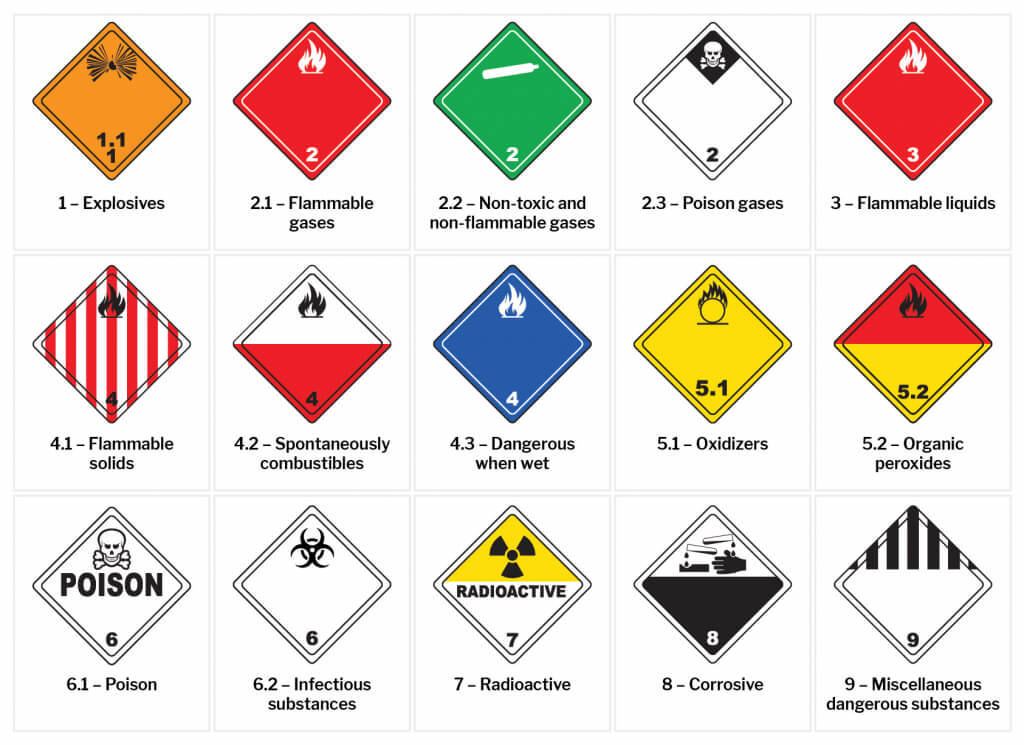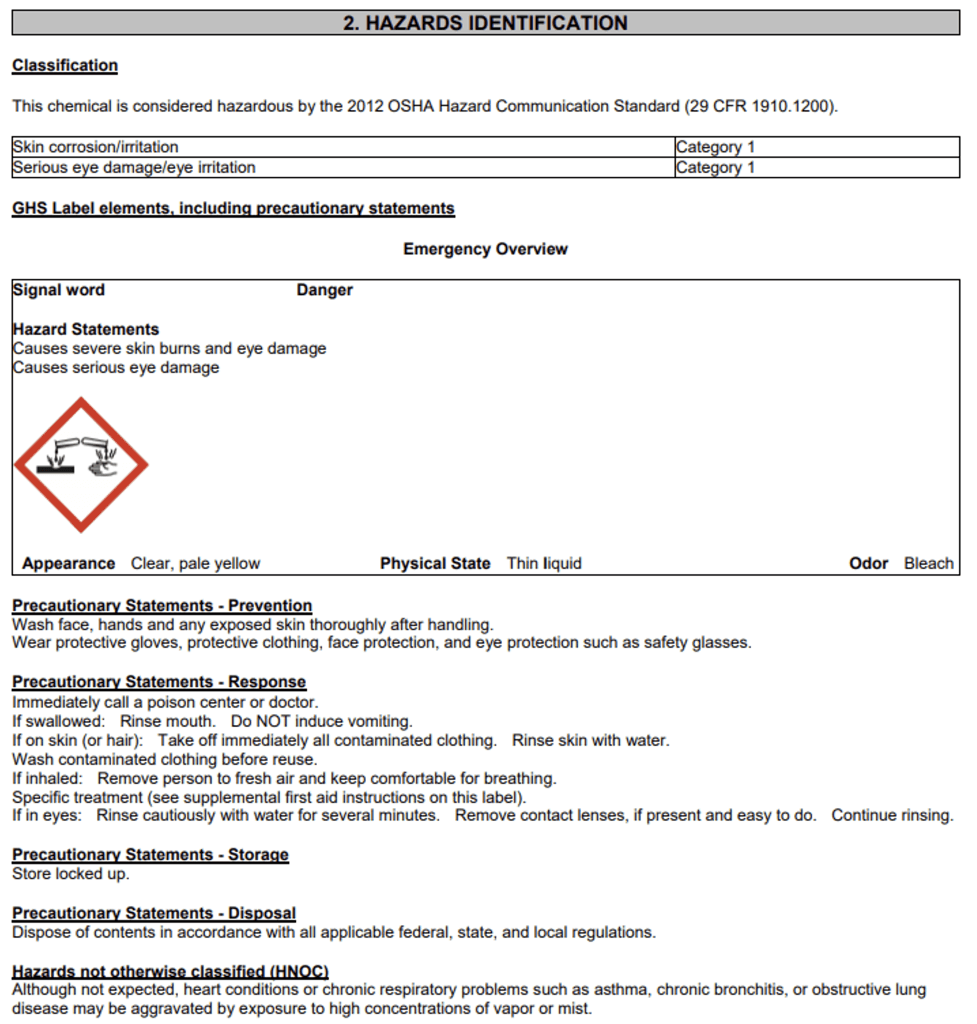Fire safety issues related to the storage and handling of consumer goods containing hazardous materials
15th June 2022
Many consumer goods contain hazardous substances. Examples are some hairspray products, alcohol based hand sanitisers, solvent based paints, thinners, disinfectants containing hydrogen peroxide and alcoholic beverages to name a few.
The rules that govern handling and storage may seem to be complicated as persons handling consumer goods are not chemical scientists or hazardous material safety assessors.
In this article I provide some background.
UN[1] Classification of hazardous materials
The UN divides dangerous goods into nine classes:
- Class 1 – Explosives – e.g. dynamite
- Class 2 – Compresses gases – e.g. nitrogen
- Class 3 – Flammable liquids – e.g. gasoline
- Class 4 – Flammable solids – e.g. sulphur, flour dust
- Class 5 – Oxidising substances and organic peroxides
- Class 6 – Poisonous substances
- Class 7 – Radioactive material
- Class 8 – Corrosives
- Class 9 – Miscellaneous dangerous goods
Some of the above-mentioned UN classes have subclasses. For example, under Class 2 compressed gasses there is subclass 2.1 which includes flammable gasses, subclass 2.2 is non-toxic and non-flammable gasses and subclass 2.3 is toxic gasses.
A UN Class 5 product (Oxidising substances and organic peroxides) will start to decompose when heated above a certain temperature. The process releases more energy which accelerates the decomposition reaction and can lead to explosive reactions.
Miscellaneous dangerous goods are those that don’t fall under any of the other categories but are considered dangerous like e.g. asbestos or certain batteries.
Distinct pictograms as indicated below will indicate the presence of dangerous substances, they are however not always shown on the consumer goods.

MSDS[2]
MSDS sheets provide the hazard classification and potential hazards for consumer goods when stored and when used.
MSDS sheets though can be misleading to a layperson and usually do not inform on permissible storage practises, quantities and code requirements.
It can also be unclear to a layperson if the MSDS applies to the product or to a substance of the product.
The picture below shows an extract of an MSDS of a bleach product.

Storage and handling
Safe storage and handling can be done by segregating the hazardous products from other products. The segregation can be by simply maintaining a safety distance or by storing the products in a dedicated compartment. Adequate fire safety measures are often required especially for those products that may include a fire hazard which are the UN class 1 to class 5 products.
The hazard is also reduced by limiting the quantities of stored products or in the manner the products are packed.
That is one of the reasons why limited amounts of hazardous materials are permitted to be stored in shops, at home or in other places such as factories and warehouses. Codes and standards such as the NFPA[3] give guidance on the maximum allowable quantities for hazardous materials that can be stored together with other precautions that are required to be taken.
NFPA 400
NFPA 400: Hazardous Materials Code, regulates how hazardous materials need to be stored and defines maximum allowable quantities for a range of hazardous products.
Note that it is important to check the definitions of each hazardous products as they may not correspond to the UN classifications.
Within the identified hazardous materials groups, there are varying categories which differentiate between different levels of hazard. The more hazardous, the less material can be stored in a specific occupancy building. Also, the level of hazard protection plays a role in the maximum amount of product that can be stored.
A building equipped with a sprinkler system for example may store more flammable liquids than a non-sprinklered building.
NFPA 30
NFPA 30: Flammable and Combustible Liquids Code, defines the storage and handling of flammable and combustible liquids in more detail. NFPA 400 refers to NFPA 30 where needed.
As there are many different flammable and combustible liquids in the industry, NFPA 30 has developed detailed fire protection schemes for various types of flammable liquids and various ways of storage and handling.
It should be noted in this regard that lubricating oils and edible oils such as sunflower oil are to be considered as combustible liquids[4] and that there is a limit of what can be stored in shops, consumer good warehouses or at home.
With regard to alcoholic beverages, anything that contains less than 50% ethanol can be stored at home when the individual storage container is less than 5 litre.
Alcohol based hand sanitisers however have higher than 50% alcohol quantity in their product and are to be considered as a flammable liquid when considering the permissible amount to be stored.
NFPA 30B
NFPA 30B: Code for the Manufacture and Storage of Aerosol Products, defines different hazard categories for the aerosols based on the type of propellant used. NFPA 30B also defines how to store the products and what precautions are required to be taken.
Aerosols are found in many products such as hairspray, deodorant sprays, insect killer, etc. The propellant can be a non-flammable gas but can also be a flammable gas. Exposure to fire can cause the spray bottles to explode and thus create projectiles. Flammable propellants will contribute to the hazard.
Needless to say, that the use of aerosols is strictly limited. In the first place by limiting the spray product volumes. Also, the aerosol container must meet certain requirements with regard to strength.
Also in the case of aerosols there are limited quantities that can be stored in consumer good warehouses and shops. NFPA 30B defines the maximum quantity that can be stored and the way it must be stored. For example, it is permitted, subjects to the approval of the local authority, to store up to 454 kg of the most hazardous (Level 3) aerosol products in a general purpose warehouse that is not protected by a sprinkler system.
Local authorities
The standards referenced above are the America NFPA standards which are widely used across the world. UK and Europe have similar standards. Most authorities however may adopt those standards but might have their own restrictions or their own specific requirements. It is therefore important that local authorities should always be consulted where there is a concern with regard to hazardous materials storage or storage of consumers goods which contain hazardous substances.
Conclusion
There are many consumer goods that contain hazardous substances. The fact that they contain hazardous substances does not always mean that they are hazardous when stored or when handled.
There are though a lot of consumer goods that are deemed common and not dangerous but that are to be considered as hazardous clearly representing a fire or other hazard.
The question to be answered is in most cases not if the product is hazardous but how hazardous the product is and what storage and handling practise is considered acceptable as per the standards.
Most authorities have regulations around storage and handling of hazardous materials.
However for consumer goods which contain hazardous substances, the regulations to be applied may not be clear.
[1] UN – United Nations
[2] MSDS – Material Safety Data Sheet
[3] NFPA – National Fire Protection Association.
[4] A combustible liquid is a liquid at can ignite when heated above their flashpoint which is above 37.8°C.
This publication presents the views, thoughts or opinions of the author and not necessarily those of HKA. Whilst we take every care to ensure the accuracy of this information at the time of publication, the content is not intended to deal with all aspects of the subject referred to, should not be relied upon and does not constitute advice of any kind. This publication is protected by copyright © 2024 HKA Global Ltd.



